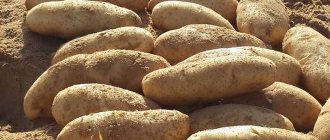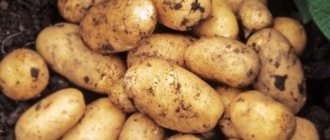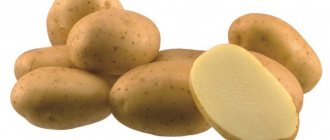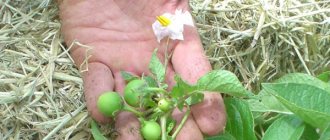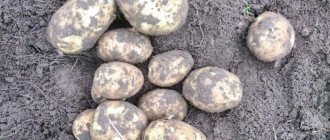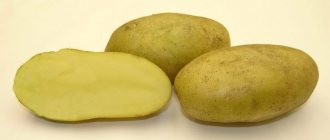Characteristics of the Ragneda potato variety
Above is a photo of the Ragneda potato variety, which matches its external description. The crop has a medium-late ripening period; it sprouts 15 days after planting the planting material. Root crops reach biological ripeness in 4 months. After 85 days, the tubers are at the stage of conditional ripeness and become suitable for consumption. Young potatoes taste no different from fully ripened ones. It has a more watery consistency, thin, unformed peel. Unripe tubers contain a low concentration of starch, so the fruits do not become soft during the cooking process.
Ragneda potatoes are adapted to temperate climates and are frost-resistant varieties. If the sprouts are damaged by returning spring frosts, the variety quickly recovers; freezing does not affect the yield level or ripening time. Ragneda potato is a drought-resistant plant; the growing season does not slow down due to moisture deficiency. The plant does not tolerate waterlogging of the soil well; excess water can cause rotting of the tubers and the lower part of the stems.
General characteristics of the variety:
- The tall bush is formed by 5 stems, reaching up to 85 cm. The stems are erect, thick, and light green. With excess moisture, the tops lose their elasticity and break easily.
- The foliage grows densely, the shape of the leaf blade is round, tapering towards the top. The surface is corrugated, with a small edge, with convex veins, the edges are smooth.
- The flowers are white with an orange core, collected in panicle-shaped inflorescences.
- The root crops are round, slightly elongated, of medium size, weighing 70-120 g. The root system forms up to 14 fruits, 90% of the potatoes in the bush are approximately the same shape. The arrangement of the tubers is compact, the root does not grow to the side.
- The peel is thin, durable, yellow in color with a smooth surface and a few eyes.
- The pulp is dense, juicy, light beige, the potatoes do not darken after peeling and at the cut site.
Thanks to its smooth, medium-sized fruits, the Ragneda variety is convenient for mechanized harvesting. It is grown over large areas for commercial purposes and the food industry. In garden plots, the variety is considered a favorite due to its unpretentiousness in care, taste and stable yield.
Important! Ragneda potato roots that have reached biological ripeness can remain in the ground for more than 3 weeks, maintaining their taste and presentation.
Reviews
According to gardeners, Rogneda potatoes deserve the highest rating for their taste. They highlight as a good feature the ideal level of starch, which helps both maintain its integrity during cooking and be a little crumbly for taste.
I liked the Rogneda potato variety - it’s tasty, productive, and stores well, you just have to have time to collect it before winter. There have been warm winters - the fruits are already sprouting in the cellar at the end of February, but there is nowhere to plant it. They prefer cool temperatures. You need to think right away so that you don’t have to break off the sprouts; next year you might lose some part of the harvest! Overall I'm pleased with the result.
I’ve been working on potatoes for many years, I’ve tried all sorts of varieties and settled on Rogneda. I started with a few bushes, and now I’ve been planting this one for many years now. I use my own prepared seeds. Potatoes keep well until mid-spring; after peeling and slicing, they are stored ideally and do not darken. When you cook it, it doesn’t crumble and it doesn’t turn out too hard. During the entire growing period, the variety never got sick! You just have to fight the Colorado potato beetles.
In recent years, I have tried many varieties of potatoes, because the old ones each time had some shortcomings and turned out to be lost. I consider the Rogneda variety to be one of the best modern varieties. Productivity is at the level, the tubers are white, do not darken and development is fast and good. I recommend!
Potatoes of the Rogneda variety are a modern variety, distinguished by the quality of their yield and unpretentiousness to soils. It has small but very tasty fruits. Available to any summer resident at a low price. It has a presentable creamy color of tubers, and in cooking too. You can safely recommend the modern Rogneda variety for cultivation and not be afraid to call it one of the best of its kind!
Potatoes are one of the most popular vegetables widely grown in Russian gardens. The fruits are used in cooking, medicinal purposes, and cosmetology. Thanks to the efforts of breeders, new, improved varieties of vegetables are being developed. Based on the description of the Rogneda potato variety and reviews about it, you can grow the plant in almost any soil, for industrial purposes or for personal consumption. You should first familiarize yourself with all the nuances.
Pros and cons of the Ragneda variety
Belarusian varieties have long been in deserved demand among farmers and consumers. Ragneda potatoes are cultivated almost throughout the entire territory of Russia, except for the risky farming zone. The variety has earned such attention due to a number of advantages:
- adapted to the temperate climate zone;
- frost-resistant, quickly replaces damaged shoots;
- goes without watering for a long time;
- fruit size is suitable for mechanized harvesting;
- seeds are not prone to degeneration;
- stable fruiting;
- high productivity;
- strong immunity;
- undemanding to soil composition and agricultural technology;
- stored for more than 8 months, waste of the total volume – 12%;
- withstands mechanical stress during transportation;
- has good taste and presentation;
- contains optimal starch index and concentration of active substances;
- the pulp retains its color after heat treatment.
The absence of shortcomings in the characteristics of the Ragneda potato variety is confirmed by reviews from vegetable growers. The only conditional disadvantage of the crop is the tendency to develop rhizoctonia in cold, damp weather with severe waterlogging of the soil.
Description
The variety is valued for its very early ripening (45-55 days after germination), rapid development at the beginning of the growing season and uniform filling of tubers.
Plants are tall, erect, with large green leaves and clusters of red-violet flowers.
Plants of intermediate type, tall (up to 75 cm), erect, abundantly covered with large leaves with slightly wavy edges. At the beginning of the growing season, development occurs intensively, the plants quickly cover the ridges with foliage. The inflorescences are medium in size, the flower corollas are anthocyanin colored on the inside. The light sprout is ovoid, heavily pubescent at the base.
Characteristics of tubers
Tubers reach large and very large sizes: on average - 130-210 g, maximum - up to 800 grams.
Round-oval tubers with red skin and light yellow flesh
The tubers are round-oval in shape with small eyes located at a depth of 0.9-1.1 mm. The peel is red, slightly rough, the flesh is light yellow, slightly mealy, practically does not darken when peeled, cut and heat treated. Taste qualities according to tasting scores - 6 points out of 9.
Tubers contain 20.3% dry matter, which includes:
| Useful and nutritious substances | Average quantity |
| Starch | 12,6-15,7% |
| Protein | 2,01% |
| Reducing sugars | 0,22% |
| Vitamin C | 17.8 mg per 100 g of product |
Among the characteristics of tubers, it is important to note the excellent indicators:
- marketability - 82-99% of the total harvest;
- keeping quality – 93-96%.
When describing the Bellarosa potato variety, one should also note the low sensitivity to glandular spot, mechanical damage, shock and the high duration of the dormant period.
According to reviews, Bellarosa potatoes exhibit their taste best when fried and are well suited for preparing other dishes - salads, soups, purees
Unlike most early-ripening varieties, "Bellarose" is successfully stored without loss of marketable and taste qualities, since it has a long dormant period and a high preservation factor (keeping quality) - about 96% even with early harvesting. Many people note that potatoes become even tastier during storage.
Productivity
The variety is high-yielding. In each nest, an average of 7-10 tubers of commercial quality are formed (maximum up to 15).
Potatoes "Bellarose", according to reviews from vegetable growers, provide a stable high yield even on heavy soils and in unfavorable weather conditions
Marketable yield indicators:
- in Russia - an average of 169-326 c/ha (26-63 c/ha higher than the Nevsky standard). During the first digging on the 45th day after full germination - 143-277 c/ha, and on the 55th (second digging) - 170-385 c/ha, which significantly exceeds the Zhukovsky Early standard. The maximum yield of 385 c/ha was recorded in the Tambov region.
- in Belarus - average 406 c/ha, maximum 564 c/ha (obtained at the Molodechno Variety Testing Station in 2012).
Sustainability
The variety is highly resistant to heat and drought, secondary growth, and is immune or resistant to many diseases:
| Diseases and pests | Degree of stability |
| Potato cancer (D1) | Very high |
| Potato golden cyst nematode (Ro1 + Ro4) | Very high |
| Virus Y (PVY) | Very high |
| Virus A (PVA) | Very high |
| Leaf curl (PLRV) | Very high |
| Blackleg | High |
| Late blight of tubers | Medium/High |
| Late blight of tops | Medium/High |
| Common scab | Medium/High |
When preparing seed potatoes for planting, treatment against rhizoctonia is recommended.
Features of cultivation
To obtain a medium-sized tuber crop, the estimated planting density is approximately 46,000 plants per hectare.
It is recommended to combine loosening the soil and hilling up bushes with the application of mineral or organic fertilizers
Agricultural technology for growing potatoes of the Bellarosa variety involves meeting standard requirements: moderate watering, weeding and loosening the soil between rows, hilling, preventive treatments against pests and weeds, pruning the tops 7-10 days before digging the main crop, regular fertilizing.
When fertilizing, the natural fertility and composition of the soil should be taken into account. "Bellarose" responds gratefully to the application of mineral and organic fertilizers according to the recommended standards:
| Fertilizers | Quantity, kg/ha |
| Nitrogen | Half the standard size |
| Phosphorus | 100 |
| Potassium | 200-250 |
| Magnesium | 60 |
Planting and caring for Ragneda potatoes
Ragneda potatoes are planted in the second half of May, the timing is coordinated with the climate. If the soil has warmed up to +160 C, planting work can begin.
Selection and preparation of a landing site
Ragneda potatoes are unpretentious to soil composition and produce a stable harvest on any soil, except lowlands and wetlands. The fruiting rate increases if the composition is fertile; preference is given to light sandy loam soil.
Attention! For photosynthesis, the Ragneda variety needs a sufficient amount of ultraviolet radiation; in the shade, the growing season slows down and the fruits become smaller.
The site has been prepared since the fall. Remove the remains of old tops and weed roots. They dig up the soil and add organic matter. In the spring, 14 days before planting the seeds, the area is dug up again and saltpeter is scattered.
Preparation of planting material
To speed up the growing season of the plant, the mid-late variety Ragneda is bred with sprouted seeds. You can purchase them or prepare them yourself. Potatoes are selected in the fall after harvest or in the spring. Take medium-sized seeds, weighing 60 g.
Planting material, prepared in boxes in the fall, is taken out for germination. In the spring, you can select the seeds and put them in a container or spread them in a thin layer on a flat surface. Seeds are prepared approximately at the end of March. Ragneda potatoes are sprouted in good light and a temperature of +80 C. Sprouts for planting should grow no more than 2.5 cm.
Landing rules
Ragneda potatoes are planted in single holes or furrows, the planting pattern is the same. The depth of the hole is 16 cm, the row spacing is 50 cm, the distance between the bushes is 35 cm. Two tubers are placed in one planting hole at a distance of 7 cm. The top is covered with a mixture of peat and ash in equal proportions, then with soil.
Watering and fertilizing
With the condition of single precipitation per month, Ragned potatoes are not additionally watered. If the summer is dry, one intensive watering is enough after 3 weeks after flowering. Fertilizing is applied in the spring a month after planting the seeds, fertilized with phosphate, potassium agents, and urea. Nitrogen-containing fertilizers are applied at the time of flowering.
Loosening and weeding
Ragneda potatoes will produce young shoots 15 days after planting the seeds. When the crop has grown enough to define rows, the first weeding is carried out. When the variety grows to 15 cm, repeated loosening is necessary to remove weeds and ensure unhindered access of oxygen to the root system. Cut weeds and roots are removed from the garden bed.
Hilling
Ragneda potatoes are hilled up when the tops grow to 25 cm. If planting was done in holes, soil is poured on all sides, up to the top leaves. When placing seeds in furrows, make a continuous mound on both sides in the form of a ridge. After 2.5 weeks the procedure is repeated:
- the embankment is trimmed;
- loosen the top layer;
- remove remaining weeds.
Growing
In order for the yield to be high, it is important to adhere to basic recommendations for cultivation and care. Potatoes are planted in an open area, not deprived of sunlight.
Light to medium soils are ideal; heavy soils can impair yields.
In the fall, the site is dug up and fertilized. It is best to use organic matter or wood ash. In the spring, the beds are dug up again, after which complex fertilizers or rotted manure are added.
Planting potatoes are selected in the fall, immediately after harvesting.
It is important to choose high-quality root vegetables that will produce powerful shoots. It is recommended to germinate the tubers before planting
To do this, root vegetables are placed in special boxes or boxes, where the air temperature is about 8 degrees. It is recommended to turn the potatoes periodically.
Rogneda is planted under favorable weather conditions. The soil should warm up to 8 degrees
When disembarking, it is important to consider the following recommendations:
- make deep enough holes;
- the holes should be at least 35 cm apart from each other, since Rogneda is characterized by spreading bushes;
- Dense planting of tubers reduces yield.
Diseases and pests
Over the past few years, the spread of the Y virus has been a problem for farms and small plots. The infection can completely destroy plantings, Ragneda potatoes were no exception. The pathogen is carried by aphids during hot, dry summers. The disease manifests itself as necrosis of the entire bush along with the root system. At the end of May, the plant is treated with insecticides to destroy the vector and larvae of the Colorado potato beetle, which parasitizes nightshades.
The fungal infection rhizoctoniasis manifests itself only under favorable conditions: low temperature and high humidity. The disease is identified by black spots on the leaves and the bottom of the tops. The infection is eliminated using Planriz, Baktofit, and crop rotation.
Harvesting and storage
Mid-late Ragneda potatoes ripen approximately at the end of August. If the crop is not harvested in a timely manner, the root crops remain unchanged in the soil, in this form they can lie until frost sets in. As a rule, harvesting is carried out promptly in early September.
Recommendations for harvesting:
- Potatoes are not left in the sun for a long time - ultraviolet radiation triggers the synthesis of solanine (a substance toxic to humans), and green fragments appear on the surface of the root crop.
- The tubers are removed to a shaded place.
- Wash and dry well (for further sale).
Potatoes are usually not washed for home storage. It is enough to spread it in a thin layer, dry it, then collect it in a container for storage.
Ragneda potatoes are stored in boxes or canvas bags, if the room allows, in bulk.
Important! Requirements for storage space: no light, temperature – no higher than +50C, air humidity – 80%.
Ragneda potatoes retain their taste and appearance until the end of May.


